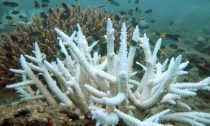
Climate change is threatening the world’s coral reefs, and saving them all will prove impossible. A team from EPFL has developed a method for identifying corals with the greatest adaptive potential to heat stress. The research, published in the journal Evolutionary Applications, should support improved and better-targeted marine biodiversity conservation strategies.
Coral reefs are home to up to one-third of global marine biodiversity and, as such, are a high conservation priority. Yet these precious ecosystems have declined rapidly in the past 20 years, resulting in significant species loss and bringing socioeconomic hardship to tropical regions of the world that rely heavily on fishing and tourism. This decline is driven by bleaching, the process by which coral dies.
Bleaching occurs when coral suffers from heat stress, which weakens the organism and can ultimately lead to its demise. “The future of coral reefs will depend on coral’s ability to adapt to warming oceans,” says Oliver Selmoni, a doctoral assistant at EPFL’s Laboratory of Geographic Information Systems (LASIG). “Temperature is the leading cause of coral death. We’ve found a way to predict which corals are best equipped to cope with heat stress – data that’s currently absent from global conservation strategies.”
It is already known that certain corals are more accustomed to surviving in warmer waters and, therefore, better able to cope with abnormal temperature spikes. But extrapolating this knowledge to the scale of an entire reef has so far proved difficult. This new piece of research is a joint effort between EPFL and the French National Research Institute for Sustainable Development (IRD) based in Nouméa, New Caledonia, with the support of the United Nations Environment Programme (UNEP) and the International Coral Reef Initiative (ICRI). In addition to developing a method for locating so-called “adaptive” corals, the team also sought to determine how this information could be used to better protect corals by reinforcing their adaptive potential.
A two-pronged study
The study marks the first time that the principles of environmental genomics have been applied to the marine environment to support coral reef conservation. The researchers focused on a flagship coral species in Japan’s Ryukyu Archipelago, cross-referencing the results of a genetic analysis with satellite data showing changes in environmental conditions – specifically, ocean temperature – over the past 30 years.
The team developed a model that uses objective, quantifiable and mappable variables to predict which genotypes are associated with adaptability and, therefore, make it more likely that a particular coral will be better suited to surviving in a given environment. They discovered six genomic regions involved in promoting resistance to heat stress. “We were able to identify individuals carrying potential heat-stress-adapted genotypes and to understand how they disperse to neighboring reefs,” says Selmoni.
Scaling up
At present, governments establish marine protected areas (MPAs) according to the level of threat posed by human activity. The EPFL team is calling for a different approach, with conservation efforts focusing on reefs with the greatest chance of survival because they carry the adapted genotypes. Another option would be to encourage genetic mutations by transplanting adaptive corals into reefs that are less able to withstand rising temperatures.
Following a successful proof of concept, the model was incorporated into a web application that ranks corals by adaptability. The tool, developed for MPAs managers, will be scaled up in the future as the EPFL team studies other coral species and adds more genotypes to the database. The model is also set to be deployed in two other parts of the world. The Transnational Red Sea Research Center, founded by Professor Anders Meibom at EPFL and supported by the Swiss Federal Department of Foreign Affairs (FDFA), will use it to support coral reef conservation work in the Red Sea, and ManaCo, a network operating in the Pacific region, will likewise add the model to its suite of marine conservation tools.












Social Profiles